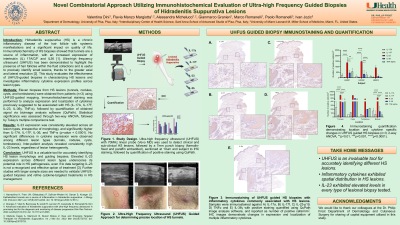Clinical Research
(CR-073) Novel Combinatorial Approach Utilizing Immunohistochemical Evaluation of Ultra-high Frequency Ultrasound Guided Biopsies of Hidradenitis Suppurativa Lesions
Friday, May 2, 2025
7:45 PM - 8:45 PM East Coast USA Time

Valentina Dini, MD – University of Pisa; Gianmarco Granieri, MD – University of Pisa; Ivan Jozic, PhD – Dermatology – University of Miami Miller School of Medicine; Flavia Manzo Margiotta, MD – University of Pisa; Alessandra Michelucci, MD – University of Pisa; Marco Romanelli, MD – University of Pisa
Introduction: Hidradenitis suppurativa (HS) is a chronic inflammatory disease of the hair follicle with systemic manifestations and a significant impact on quality of life. Immunohistochemistry of HS biopsies showed that tunnels are a source of inflammation, with an increased expression of interleukin (IL) 17A/C/F and IL36a [1]. Ultra-high frequency ultrasound (UHFUS) has been demonstrated to highlight the presence of hair follicles within the fluid collections and is useful to precisely identify small lesions, thanks to the greater axial and lateral resolution [2]. This study evaluates the effectiveness of UHFUS-guided biopsies in characterizing HS lesions and investigates inflammatory cytokine expression profiles across lesion types.
Methods: Eleven biopsies from HS lesions (tunnels, nodules, cysts, and tombstones) were obtained from patients (n=3) using UHFUS-guided mapping. Immunohistochemical staining was performed to analyze expression and localization of cytokines previously suggested to be associated with HS (IL-17A, IL-17F, IL-23, IL-36, TNF-α), followed by quantification of obtained signal via bioimage analysis software (QuPath). Statistical significance was assessed through two-way ANOVA, followed by Tukey’s multiple comparisons test.
Results: IL-23 expression was consistently elevated across all lesion types, irrespective of morphology, and significantly higher than IL-17A, IL-17F, IL-36, and TNF-α (p-value < 0.0001). No significant differences in cytokine expression were observed among different lesion types (tunnels, nodules, cysts, tombstones). Inter-patient analysis revealed consistently high IL-23 levels, regardless of lesion heterogeneity.
Discussion: UHFUS is a valuable tool for accurately identifying HS lesion morphology and guiding biopsies. Elevated IL-23 expression across different lesion types underscores its potential role in HS pathogenesis, even if to date targeting IL-23 is not a recognized and effective option of treatment [3]. Further studies with larger sample sizes are needed to validate UHFUS-guided biopsies and refine cytokine-targeted treatments in HS management.
Methods: Eleven biopsies from HS lesions (tunnels, nodules, cysts, and tombstones) were obtained from patients (n=3) using UHFUS-guided mapping. Immunohistochemical staining was performed to analyze expression and localization of cytokines previously suggested to be associated with HS (IL-17A, IL-17F, IL-23, IL-36, TNF-α), followed by quantification of obtained signal via bioimage analysis software (QuPath). Statistical significance was assessed through two-way ANOVA, followed by Tukey’s multiple comparisons test.
Results: IL-23 expression was consistently elevated across all lesion types, irrespective of morphology, and significantly higher than IL-17A, IL-17F, IL-36, and TNF-α (p-value < 0.0001). No significant differences in cytokine expression were observed among different lesion types (tunnels, nodules, cysts, tombstones). Inter-patient analysis revealed consistently high IL-23 levels, regardless of lesion heterogeneity.
Discussion: UHFUS is a valuable tool for accurately identifying HS lesion morphology and guiding biopsies. Elevated IL-23 expression across different lesion types underscores its potential role in HS pathogenesis, even if to date targeting IL-23 is not a recognized and effective option of treatment [3]. Further studies with larger sample sizes are needed to validate UHFUS-guided biopsies and refine cytokine-targeted treatments in HS management.

.jpg)